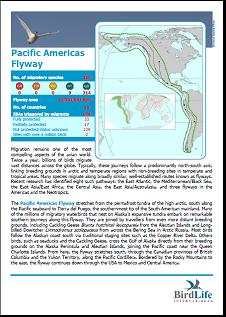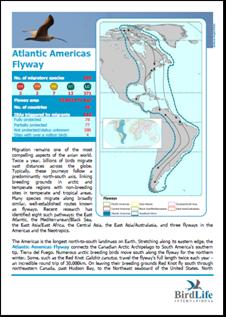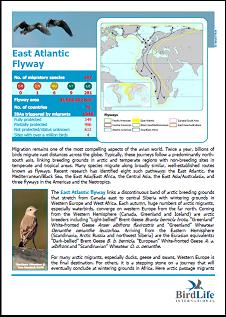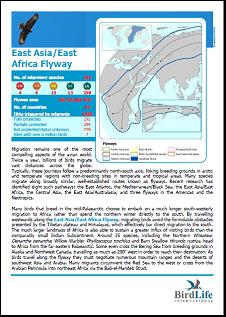|
Migration is one of the most fascinating aspects of the avian world. Twice a year, billions of birds migrate vast distances across the globe. Many species migrate along broadly similar, well-established routes known as flyways. Unfortunately, many of the world’s migratory species are in decline, assailed by multiple threats, including habitat loss and degradation, illegal and unsustainable hunting, infrastructure development, climate change and disease. The conservation of migratory birds depends on international collaboration and a coordinated conservation response along their flyways. |
Birds are arguably the most mobile creatures on Earth, often undertaking truly epic journeys (![]() ,
, ![]() ).The area covered by a migrant over the course of its annual cycle, encompassing breeding and non-breeding grounds and the connecting migration route, is known as a flyway (
).The area covered by a migrant over the course of its annual cycle, encompassing breeding and non-breeding grounds and the connecting migration route, is known as a flyway (![]() ).
).
Unfortunately, many of the world’s migratory birds are in decline (![]() ,
, ![]() ). Undertaking such dramatic journeys can push birds to the limit of their endurance as they are reliant on favourable weather conditions and the presence of adequate food resources at multiple sites throughout their migration. The most serious threat is the loss and modification of natural habitats (
). Undertaking such dramatic journeys can push birds to the limit of their endurance as they are reliant on favourable weather conditions and the presence of adequate food resources at multiple sites throughout their migration. The most serious threat is the loss and modification of natural habitats (![]() ). Migratory waterbirds in Asia are particularly affected, with many of the region’s remaining wetlands threatened through land reclamation for agriculture and development (
). Migratory waterbirds in Asia are particularly affected, with many of the region’s remaining wetlands threatened through land reclamation for agriculture and development (![]() ). Some sites are critical: for example, Delaware Bay, USA, where the unsustainable exploitation of horseshoe crab has contributed to the collapse of the Red Knot Calidris canutus population (
). Some sites are critical: for example, Delaware Bay, USA, where the unsustainable exploitation of horseshoe crab has contributed to the collapse of the Red Knot Calidris canutus population (![]() ).
).
Another significant threat is widespread hunting. In some parts of the world migratory birds are hunted for food or as a culinary delicacy, elsewhere it is purely recreational (![]() ). In addition to direct mortality, hunting also poses a threat through disturbance and pollution with thousands of tonnes of highly toxic lead pellets discharged around the world annually (
). In addition to direct mortality, hunting also poses a threat through disturbance and pollution with thousands of tonnes of highly toxic lead pellets discharged around the world annually (![]() ). Larger species, such as storks and raptors, face the additional risk of collision with man-made structures such as powerlines and wind turbines (
). Larger species, such as storks and raptors, face the additional risk of collision with man-made structures such as powerlines and wind turbines (![]() ,
, ![]() ,
, ![]() ).
).
Over the coming decades, climate change is anticipated to have a dramatic impact on the distribution and survival of migratory birds (![]() ). Climate change may also affect some species by uncoupling the timing of resource availability from the timing of migration. For example, whilst the brood-parasitic Common Cuckoo Cuculus canorus has advanced its migration only modestly, many of its host species are now arriving at the breeding grounds considerably earlier. Migrants typically have smaller brains and are less flexible in behaviour and resource use than resident species. Consequently, they may be less able to adapt to changes in climate than non-migratory species (
). Climate change may also affect some species by uncoupling the timing of resource availability from the timing of migration. For example, whilst the brood-parasitic Common Cuckoo Cuculus canorus has advanced its migration only modestly, many of its host species are now arriving at the breeding grounds considerably earlier. Migrants typically have smaller brains and are less flexible in behaviour and resource use than resident species. Consequently, they may be less able to adapt to changes in climate than non-migratory species (![]() ).
).
Migratory waterbirds are also prone to periodic outbreaks of infectious disease at sites where they congregate Avian botulism is perhaps the most important disease affecting migratory birds worldwide. In 2002–2003, an outbreak in Taiwan killed more than 7% of the global population of the threatened Black-faced Spoonbill Platalea minor (![]() ).
).
In the face of such a diverse array of threats, the conservation of migratory birds depends on international collaboration and a coordinated response across entire flyways (![]() ). The Convention on Migratory Species (CMS), stresses the need for coherent ecological networks of transboundary protected areas. Important Bird Areas (IBAs) can make a crucial contribution to identifying critical sites for migrants and in many regions the inventory has been used as a ‘shadow list’ to identify potential Ramsar sites (Wetlands of International Importance) (
). The Convention on Migratory Species (CMS), stresses the need for coherent ecological networks of transboundary protected areas. Important Bird Areas (IBAs) can make a crucial contribution to identifying critical sites for migrants and in many regions the inventory has been used as a ‘shadow list’ to identify potential Ramsar sites (Wetlands of International Importance) (![]() ).
).
The effective conservation of migratory birds requires a coordinated response on a global scale. BirdLife is ideally placed to deliver this, with national partners throughout all major flyways. For example, BirdLife’s Sustainable Hunting Project (2004-2007) brought together national governments, hunting groups and conservation organisations from across North Africa and the Middle East to tackle the problem of migratory bird hunting in the Mediterranean (![]() ).
).
The Wings over Wetlands (WOW) initiative was a flyway-scale approach to the conservation of migratory waterbirds involving collaboration between BirdLife, Wetlands International, the Ramsar Convention on Wetlands, the United Nations Environment Programme’s World Conservation Monitoring Centre (UNEP-WCMC), and a range of local partners along the African-Eurasian Flyways. The Agreement on the Conservation of African-Eurasian Migratory Waterbirds (AEWA) is the largest multilateral Agreement concluded under the CMS. The WOW project, which ran from 2006 to 2010, aimed to support the implementation of the agreement by identifying critical sites for migratory waterbirds within the AEWA region (![]() ). As part of the WOW initiative, a number of conservation projects were implemented by national BirdLife Partners (
). As part of the WOW initiative, a number of conservation projects were implemented by national BirdLife Partners (![]() ,
, ![]() ). For example, BirdLife’s Hungarian Partner (MME) introduced a ‘nature friendly’ fish-farming strategy; helping to safeguard an internationally important waterbird breeding site and staging ground (
). For example, BirdLife’s Hungarian Partner (MME) introduced a ‘nature friendly’ fish-farming strategy; helping to safeguard an internationally important waterbird breeding site and staging ground (![]() ).
).
In order to effectively target conservation action, it is essential to understand the distribution and ecology of migratory species, and especially the migration routes that they follow. Until recently, the African wintering grounds of the Aquatic Warbler Acrocephalus paludicola were unknown, hampering efforts to conserve the species. However, in 2007, following five years of investigation, a research team from BirdLife and the RSPB (BirdLife Partner in the UK) finally succeeded in tracing the birds to an area of northwest Senegal (![]() ). Elsewhere, BirdLife Partners are targeting research at some of the world’s most imperilled migratory species in order to better understand their conservation needs (
). Elsewhere, BirdLife Partners are targeting research at some of the world’s most imperilled migratory species in order to better understand their conservation needs (![]() ,
, ![]() ).
).
To access these and other case studies on flyways, please click on the following links.
Flyway factsheets
The following factsheets present information on eight major global flyways.
 |
 |
 |
 |
|||
 |
 |
 |
 |
|||
| East Asia & East Africa Flyway | Central Asia Flyway | East Asia & Australasia Flyway |
Links
African-Eurasian Migratory Waterbird Agreement (AEWA)
The Critical Site Network Tool
The Convention on Migratory Species
World Migratory Bird Day 2011
Wings over Wetlands
Compiled 2010
Recommended citation
BirdLife International (2010) Spotlight on flyways. Presented as part of the BirdLife State of the World's Birds website. Available from: https://datazone.birdlife.org/sowb/spotflyway